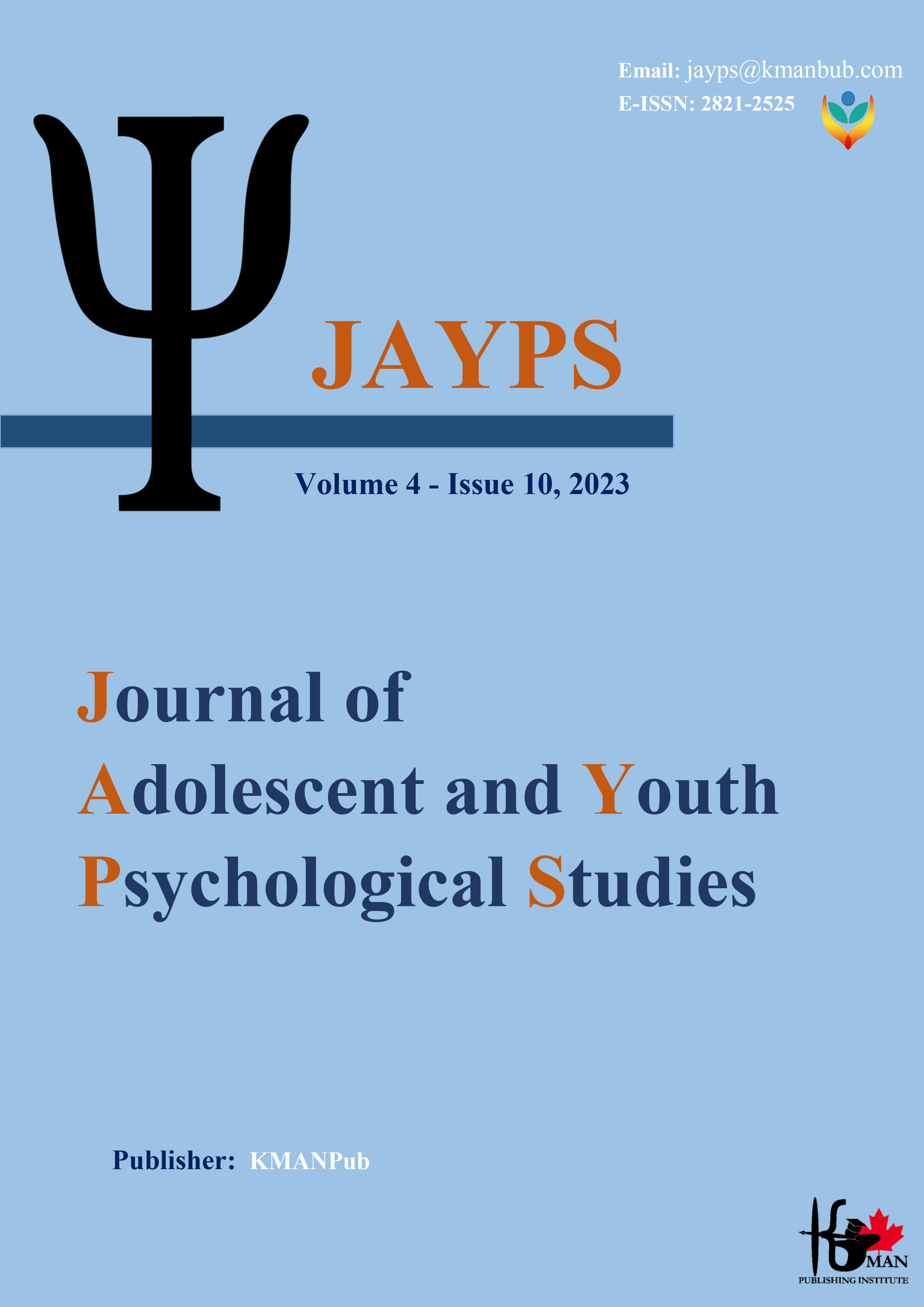Exploring the Indicators of Self-Silencing in Adolescent Romantic Relationships
Keywords:
self-silencing, adolescence, romantic relationships, emotional expression, qualitative research, gender norms, relational dynamicsAbstract
Objective: This study aimed to explore the psychological, relational, and sociocultural indicators of self-silencing in adolescent romantic relationships.
Methods and Materials: This qualitative research employed an exploratory-descriptive design and included 25 adolescents aged 15 to 19 from Bulgaria who had been involved in at least one romantic relationship. Participants were selected through purposive sampling and data collection continued until theoretical saturation was reached. Semi-structured in-depth interviews were conducted in private settings, recorded with consent, and transcribed verbatim. Data were analyzed thematically using NVivo software, involving open, axial, and selective coding to identify categories, subcategories, and underlying concepts. Trustworthiness was ensured through member checking, peer debriefing, and maintenance of an audit trail.
Findings: Three main categories were identified: emotional inhibition, power imbalance and control, and relational expectations and social norms. Subcategories under emotional inhibition included fear of rejection, shame, internalized gender norms, low emotional literacy, and discomfort with intimacy. Power imbalance and control were reflected in dominant partner behavior, fear of escalation, and emotional dependency. Relational expectations and social norms encompassed idealized views of relationships, peer influence, and cultural values promoting harmony and silence. Participants frequently described self-silencing as a strategy to maintain relationships, avoid conflict, or protect their emotional vulnerability. Gendered expectations, lack of emotional skills, and fear of judgment emerged as central factors.
Conclusion: Self-silencing in adolescent romantic relationships is a multifaceted phenomenon shaped by emotional vulnerability, relational dynamics, and cultural expectations.
Downloads
References
Abadali, K. R., Asatsa, S., & Ntaragwe, M. (2021). Adolescents' Social Networking and Self-Concept in Public Mixed Day Secondary Schools in Kajiado North Sub-County, Kenya. International Journal of Research and Innovation in Social Science, 05(07), 841-847. https://doi.org/10.47772/ijriss.2021.5745
Bosacki, S. (2022). Multifaceted Silences in Adolescence. 151-161. https://doi.org/10.5040/9781350162181.0022
Bosacki, S. (2024). Solitude, Silence and Loneliness in Adolescence. https://doi.org/10.5040/9781350345690
Cole, M., & Higgins, J. P. T. (2023). Self-Silencing. 61-68. https://doi.org/10.4324/9781003296683-8
Dedahanov, A. T., Abdurazzakov, O. S., Fayzullaev, A. K. u., & Sun, W. (2021). When Does Abusive Supervision Foster Ineffectual and Defensive Silence? Employee Self-Efficacy and Fear as Contingencies. Sustainability, 14(1), 231. https://doi.org/10.3390/su14010231
Emran, A., Iqbal, N., & Dar, K. A. (2022). Attachment Orientation and Depression: A Moderated Mediation Model of Self-Silencing and Gender Differences. International Journal of Social Psychiatry, 69(1), 173-181. https://doi.org/10.1177/00207640221074919
Fortin, L., Jean-Thorn, A., Allard-Cobetto, P., Théorêt, V., & Hébert, M. (2024). The Interplay of Self-Esteem in the Relationship Between Sexual Dating Violence and Self-Silencing in Adolescent Girls. Partner Abuse, 15(4), 511-523. https://doi.org/10.1891/pa-2023-0061
Goldner, L., Jakobi, C. D., Schorr, S., Dakak, S., & Shawahne, N. (2022). Keep It Quiet: Mother–daughter Parentification and Difficulties in Separation–individuation Shaping Daughters’ Authentic/True Self and Self-Silencing: A Mediation Model. Psychoanalytic Psychology, 39(2), 165-174. https://doi.org/10.1037/pap0000352
Jakubowski, K. P., Barinas‐Mitchell, E., Chang, Y. F., Maki, P. M., Matthews, K. A., & Thurston, R. C. (2021). The Cardiovascular Cost of Silence: Relationships Between Self-Silencing and Carotid Atherosclerosis in Midlife Women. Annals of Behavioral Medicine, 56(3), 282-290. https://doi.org/10.1093/abm/kaab046
Khoza, T. V., & Mokgatle, M. (2023). Maladaptive Behaviours of Maternal Orphans in High Schools of Tshwane North of Gauteng, South Africa. African Journal of Primary Health Care & Family Medicine, 15(1). https://doi.org/10.4102/phcfm.v15i1.3887
LeBlanc, S. S. (2024). Breaking the Cycle: Memorable Messages of “Grin N’ Bear It” and Silence in Menarche Narrative Recall. Qualitative Research in Medicine & Healthcare, 8(2). https://doi.org/10.4081/qrmh.2024.12239
Marettih, A. K. E., Ikhwanisifa, I., Widiningsih, Y., & Yovanny, C. P. (2024). Peran Harga Diri Terhadap Ketidakpuasan Bentuk Tubuh Remaja Perempuan. Psychopolytan Jurnal Psikologi, 8(1), 44-52. https://doi.org/10.36341/psi.v8i1.4213
Monthuy‐Blanc, J., Lemieux, V., Thériault, J., & Rousseau, M. (2020). Exploratory Study: A Blind Integrated School-Based Prevention Program on Eating Disorders and Obesity. Canadian Journal of Community Mental Health, 39(4), 61-84. https://doi.org/10.7870/cjcmh-2020-027
MÜRtezaoĞLu, Ç., & Çıkrıkçı, Ö. (2022). Ergenlerde Mutluluk, Öz-Yeterlik, Akran İlişkileri Ve Sosyal Onay İhtiyacı Arasındaki İlişkilerin İncelenmesi. Erzincan Üniversitesi Eğitim Fakültesi Dergisi, 24(3), 483-498. https://doi.org/10.17556/erziefd.1103962
O’Grady, T. (2023). Infinite Spaces: Kevin Barry’s Lives of Quiet Desperation. 109-129. https://doi.org/10.1007/978-3-031-30455-2_6
Puzio, A., & Best, D. L. (2020). Brief Report: Gender and Ethnicity Predict Adolescent Self‐silencing Above and Beyond Gender Ideology. Journal of adolescence, 84(1), 243-250. https://doi.org/10.1016/j.adolescence.2020.09.011
Ruzibiza, Y. (2021). Silence as Self-Care: Pregnant Adolescents and Adolescent Mothers Concealing Paternity in Mahama Refugee Camp, Rwanda. Sexuality & Culture, 26(3), 994-1011. https://doi.org/10.1007/s12119-021-09928-4
Sheppe, A. H. (2023). The Sound of Silence: Engaging the Quiet Adolescent. Psychodynamic Psychiatry, 51(2), 185-205. https://doi.org/10.1521/pdps.2023.51.2.185
Shrivastava, A. (2021). Self-Silencing With Its Roots in Automatic Thoughts: A Study on Women. Ensemble, 2(2), 249-255. https://doi.org/10.37948/ensemble-2021-0202-a025
Tchidjo, A., & Mgbwa, V. (2020). Sexual Violence, the Law of Silence and Building of Identity Process in the Adolescence. Psycho Affective Analysis of Two Real Life Rape Experiences in Cameroon. Jep. https://doi.org/10.7176/jep/11-28-10
Zimmermann, R., Fürer, L., Schenk, N., Koenig, J., Röth, V., Schlüter-Müller, S., Kaess, M., & Schmeck, K. (2021). Silence in the Psychotherapy of Adolescents With Borderline Personality Pathology. Personality Disorders Theory Research and Treatment, 12(2), 160-170. https://doi.org/10.1037/per0000402
Zuković, S., & Stojadinović, D. (2022). Positive Discipline in the Family as a Resource in the Development of Self-Esteem in Adolescence. Nastava I Vaspitanje, 71(2), 183-197. https://doi.org/10.5937/nasvas2202183z
Zulkefly, N. S., Shakir, A. Y. M., Baharudin, R., Arshat, Z., & Ismail, Z. (2021). Maternal Attachment and Cognitive Distortion of Muslim Adolescents in Juvenile Rehabilitation Residential Schools: Self-Regulation as Mediating Mechanism. Journal of Muslim Mental Health, 15(2). https://doi.org/10.3998/jmmh.415
Иванова, И., Buslaeva, E. Y., & Astahova, L. (2020). The Study of the Readiness of Adolescents to Self-Development in Line With the Existential Approaches in Pedagogy: Results of an Pilot Examination. Applied Psychology and Pedagogy, 5(3), 56-75. https://doi.org/10.12737/2500-0543-2020-46-65

Downloads
Additional Files
Published
Submitted
Revised
Accepted
Issue
Section
License
Copyright (c) 2024 Georgi Petrov (Author); Ivan Dimitrov (Corresponding Author)

This work is licensed under a Creative Commons Attribution-NonCommercial 4.0 International License.








